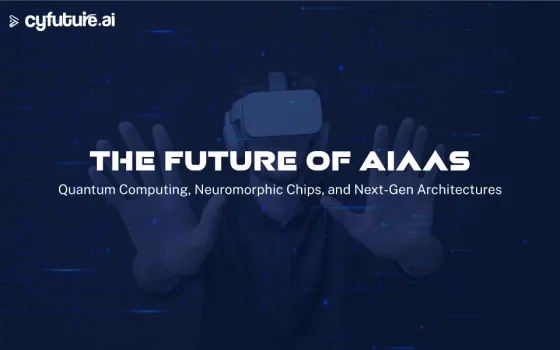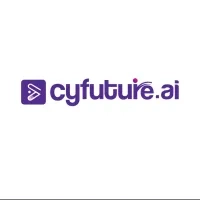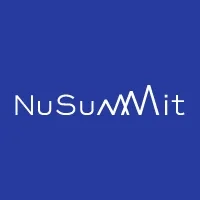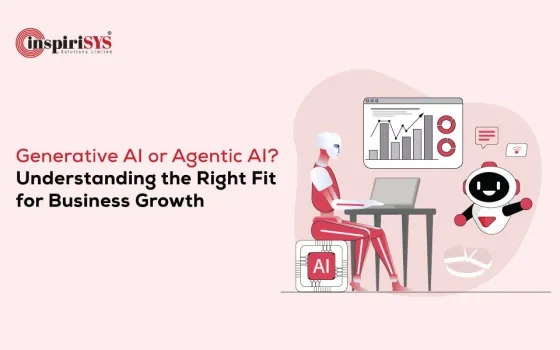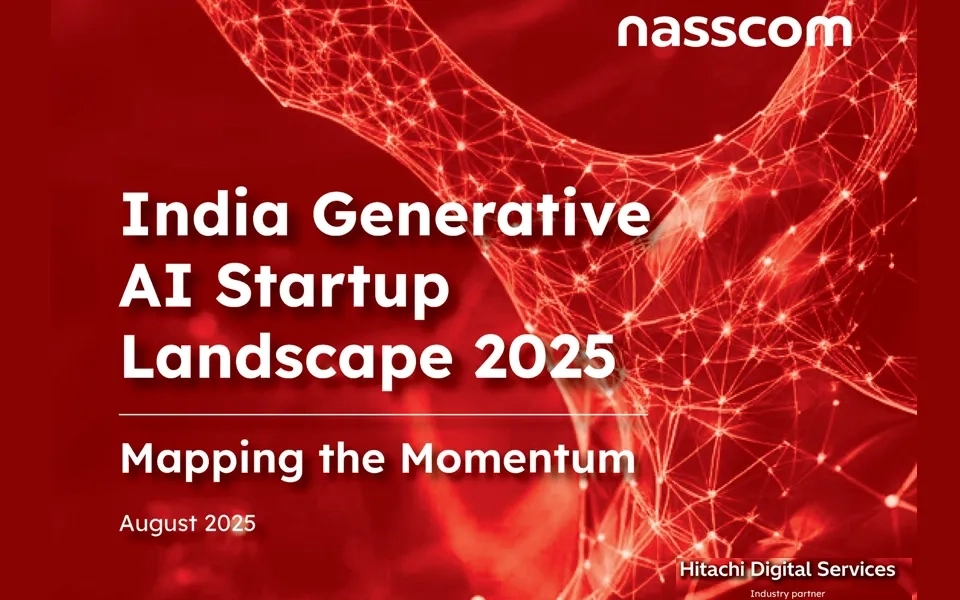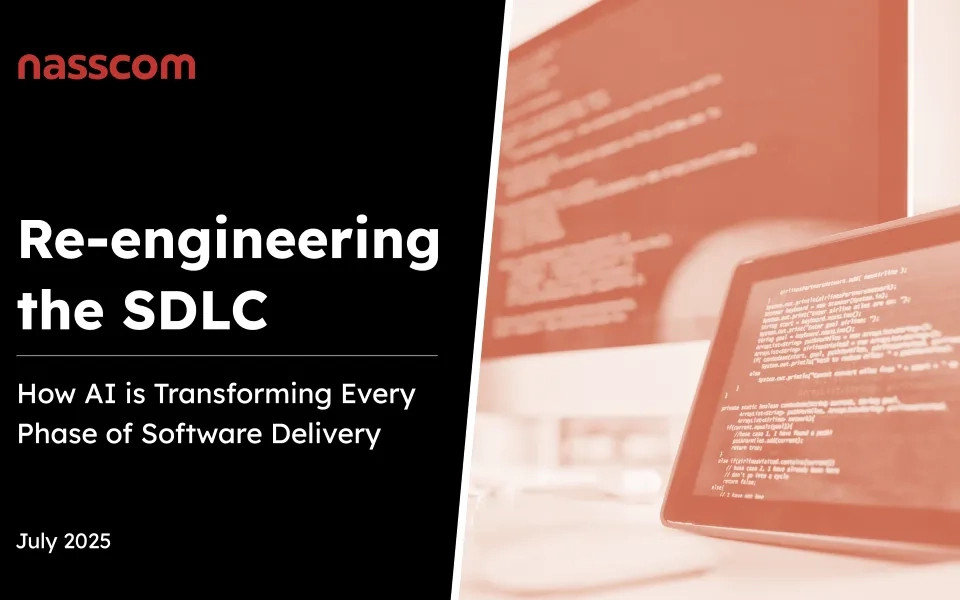In 2019, Google's Sycamore quantum processor solved a calculation in 200 seconds that would take the world's fastest supercomputer 10,000 years. Fast forward to 2025, and we're witnessing the convergence of quantum computing, neuromorphic chips, and revolutionary architectures that promise to redefine AI-as-a-Service (AIaaS) from the ground up. The question isn't whether these technologies will transform enterprise AI—it's how quickly your organization can adapt to the seismic shift that's already underway.
The Current AIaaS Landscape: At the Precipice of Transformation
Today's AIaaS market, valued at $15.7 billion in 2024 and projected to reach $148.4 billion by 2030, operates predominantly on traditional silicon-based architectures. However, we're approaching the physical limits of Moore's Law, with transistor scaling becoming increasingly challenging and expensive. Current GPU-based training of large language models like GPT-4 consumes approximately 50 GWh of electricity—enough to power 4,600 homes for a year. This computational bottleneck is driving the urgent need for revolutionary computing paradigms.
The enterprise reality is stark: 73% of organizations report that AI workloads are constrained by current computational limitations, while 68% cite energy costs as a significant barrier to AI adoption at scale. These challenges are catalyzing investment in next-generation computing architectures that promise to deliver exponential improvements in performance, efficiency, and capability.
Quantum Computing: Redefining the Computational Frontier
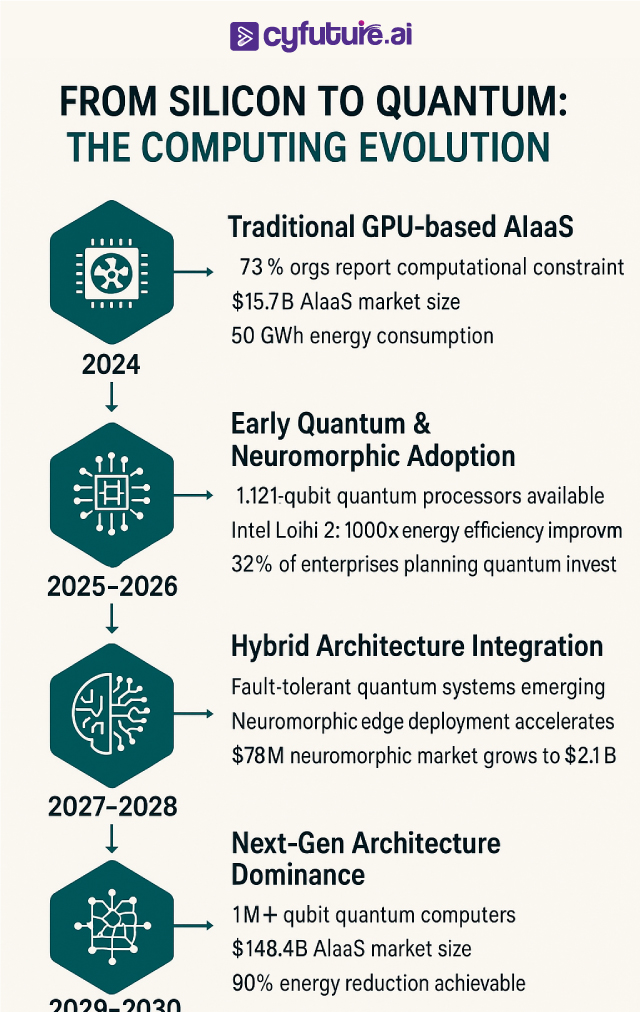
The Quantum Advantage in AIaaS
Quantum computing represents a fundamental departure from classical computing, leveraging quantum mechanical phenomena like superposition and entanglement to process information in ways that are impossible with traditional bits. For AIaaS providers, quantum computing offers unprecedented opportunities to tackle computationally intractable problems.
Current quantum systems like IBM's 1,121-qubit Condor processor and Google's 70-qubit Sycamore are already demonstrating quantum advantage in specific domains. By 2030, industry analysts predict quantum computers will achieve 1 million physical qubits, enabling fault-tolerant quantum computation that could revolutionize AI workloads.
Quantum Machine Learning: Beyond Classical Limitations
Quantum machine learning (QML) algorithms are showing remarkable promise in several key areas:
Optimization Problems: Quantum annealing systems like D-Wave's Advantage can solve complex optimization problems with 5,000+ variables—critical for supply chain optimization, portfolio management, and resource allocation at enterprise scale.
Pattern Recognition: Quantum neural networks demonstrate exponential speedups for certain pattern recognition tasks, with recent research showing 16x improvements in training time for specific classification problems.
Cryptographic Applications: Quantum computers threaten current encryption methods but simultaneously enable quantum-secure communication protocols, creating new opportunities for secure AIaaS offerings.
Market Impact and Investment Trends
The quantum computing market is experiencing explosive growth, with global investment reaching $2.4 billion in 2024. Major cloud providers are rapidly expanding quantum offerings:
- IBM Quantum Network: Over 200 members, including Fortune 500 companies
- Amazon Braket: Providing access to quantum hardware from multiple vendors
- Microsoft Azure Quantum: Full-stack quantum development platform
- Google Quantum AI: Focus on fault-tolerant quantum computing
Enterprise adoption is accelerating, with 32% of large organizations planning quantum computing investments within the next three years, primarily for optimization, simulation, and machine learning applications.
Neuromorphic Computing: Mimicking the Brain's Efficiency
The Biological Inspiration
The human brain processes information using approximately 20 watts of power—roughly equivalent to a light bulb—while performing complex cognitive tasks that require massive computational resources in traditional systems. Neuromorphic chips attempt to replicate this efficiency by mimicking the brain's neural structure and information processing methods.
Leading Neuromorphic Architectures
Intel Loihi 2: This second-generation neuromorphic chip contains 1 million artificial neurons and supports up to 120 million synapses. In benchmark tests, Loihi 2 demonstrates 1000x better energy efficiency compared to conventional processors for certain AI workloads.
IBM TrueNorth: With 1 million programmable neurons and 256 million synapses, TrueNorth consumes only 65 milliwatts during operation—orders of magnitude less than traditional processors performing similar tasks.
BrainChip Akida: This commercial neuromorphic processor offers edge AI capabilities with ultra-low power consumption, targeting applications in autonomous vehicles, smart cameras, and IoT devices.
Neuromorphic Advantages for AIaaS
Neuromorphic computing offers several compelling advantages for AIaaS providers:
Energy Efficiency: Neuromorphic chips can reduce power consumption by 100-1000x for specific AI workloads, dramatically reducing operational costs and environmental impact.
Real-time Processing: Event-driven processing enables microsecond response times, crucial for real-time AI applications like autonomous driving and industrial automation.
Adaptive Learning: Unlike traditional processors, neuromorphic chips can learn and adapt in real-time without explicit reprogramming, enabling more dynamic and responsive AI services.
Edge Computing: Ultra-low power consumption makes neuromorphic chips ideal for edge AI deployments, extending AIaaS capabilities to resource-constrained environments.
Next-Generation Architectures: Beyond Traditional Paradigms
Photonic Computing: The Speed of Light
Photonic computing leverages light instead of electricity to process information, offering potential advantages in speed, power efficiency, and parallel processing capabilities. Lightmatter's photonic interconnects have demonstrated 10x improvements in data center efficiency, while Xanadu's photonic quantum computers are exploring new frontiers in quantum machine learning.
Key benefits include:
- Bandwidth: Optical systems can handle terahertz frequencies, far exceeding electronic limitations
- Parallel Processing: Light-based systems can perform matrix operations in parallel, ideal for AI workloads
- Energy Efficiency: Photonic systems consume significantly less power than electronic equivalents
DNA Computing: Biological Information Processing
DNA computing represents an exotic but promising approach to computation, leveraging the information storage and processing capabilities of biological molecules. Microsoft's DNA storage system has demonstrated the ability to store 1 exabyte of data in a space smaller than a sugar cube, with potential applications in long-term AI model storage and retrieval.
Hybrid Architectures: The Best of All Worlds
The future of AIaaS likely lies not in any single technology but in hybrid architectures that combine the strengths of different computing paradigms:
Quantum-Classical Hybrids: Combining quantum processors for specific optimization tasks with classical systems for general computation Neuromorphic-Digital Integration: Using neuromorphic chips for real-time processing while leveraging traditional processors for training and complex calculations Photonic-Electronic Systems: Integrating photonic interconnects and processing units with electronic control systems
Industry Implications and Strategic Considerations
Performance Revolution
The convergence of these technologies promises dramatic performance improvements:
Training Efficiency: Quantum algorithms could reduce training time for certain neural networks from weeks to hours Inference Speed: Neuromorphic chips enable microsecond inference times for real-time applications Scalability: New architectures support massive parallelization, enabling AIaaS providers to serve millions of concurrent users
Cost Optimization
Next-generation computing architectures offer significant cost advantages:
Energy Savings: Neuromorphic and photonic systems could reduce data center energy consumption by 90% Hardware Costs: Quantum cloud services eliminate the need for expensive quantum hardware investments Operational Efficiency: Automated optimization and adaptive systems reduce manual intervention requirements
New Service Categories
These technologies enable entirely new categories of AIaaS offerings:
Quantum-Enhanced AI: Services that leverage quantum algorithms for optimization, simulation, and machine learning Ultra-Low Latency AI: Real-time AI services powered by neuromorphic chips Distributed Intelligence: Edge AI services that bring intelligence closer to data sources
Market Projections and Investment Opportunities
Market Size and Growth
The next-generation computing market is experiencing unprecedented growth:
Quantum Computing: $1.3 billion in 2024, projected to reach $15.4 billion by 2030 Neuromorphic Chips: $78 million in 2024, expected to grow to $7.8 billion by 2030 Photonic Computing: $1.8 billion in 2024, forecasted to reach $11.9 billion by 2030
Investment Landscape
Venture capital and corporate investment in next-generation computing reached $8.2 billion in 2024, with major technology companies leading the charge:
Google: $3+ billion invested in quantum computing research and development IBM: $2.5 billion committed to quantum and neuromorphic computing Intel: $1.8 billion in neuromorphic and photonic computing initiatives Microsoft: $1.2 billion in quantum computing and related technologies
Implementation Roadmap for Enterprises
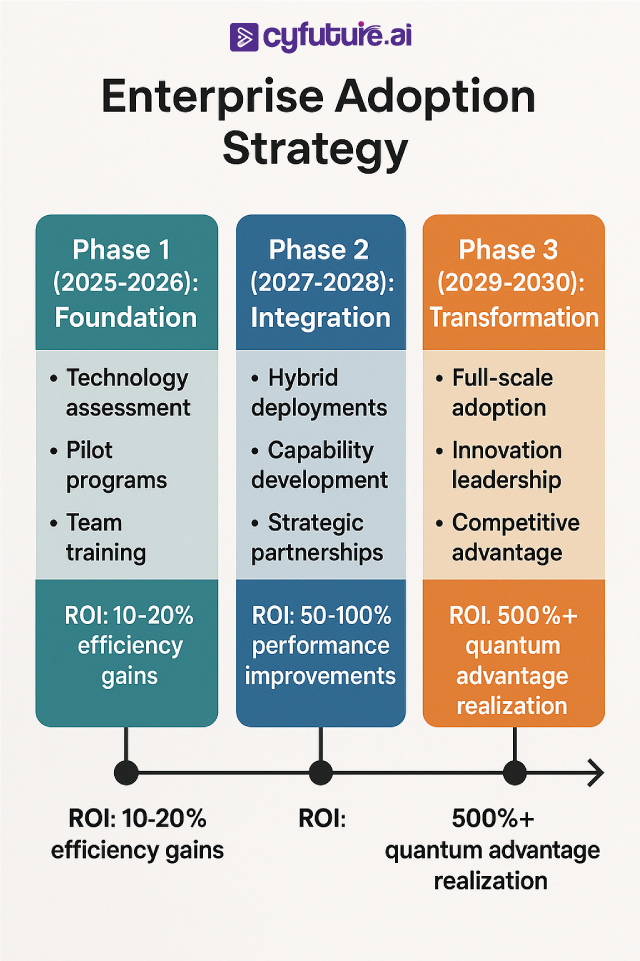
Technical Challenges and Mitigation Strategies
Quantum Computing Challenges
Quantum Decoherence: Current quantum systems are extremely sensitive to environmental interference, limiting computation time to microseconds. Mitigation strategies include improved error correction codes, better isolation techniques, and hybrid quantum-classical algorithms that minimize quantum computation time.
Scalability: Building fault-tolerant quantum computers requires millions of physical qubits to create thousands of logical qubits. Companies should focus on near-term intermediate-scale quantum (NISQ) applications while hardware matures.
Skill Gap: Quantum programming requires specialized knowledge of quantum mechanics and novel programming paradigms. Organizations should invest in quantum education and partner with universities and specialized training providers.
Neuromorphic Computing Challenges
Programming Complexity: Neuromorphic systems require fundamentally different programming approaches compared to traditional processors. Development of high-level programming frameworks and tools is essential for broader adoption.
Limited Ecosystems: The neuromorphic software ecosystem is still immature compared to traditional computing. Early adopters should focus on specific applications where neuromorphic advantages are clear and significant.
Integration Difficulties: Combining neuromorphic chips with existing infrastructure requires careful system design and potentially custom hardware solutions.
Security and Compliance Considerations
Quantum Security Implications
The advent of large-scale quantum computers poses both threats and opportunities for cybersecurity:
Cryptographic Vulnerabilities: Shor's algorithm could break current RSA and elliptic curve cryptography within decades. Organizations must begin transitioning to post-quantum cryptographic standards.
Quantum Key Distribution: Quantum communication protocols offer theoretically unbreakable security, creating new opportunities for secure AIaaS offerings.
Data Privacy in Neuromorphic Systems
Neuromorphic systems' always-on, adaptive nature raises new privacy considerations:
Continuous Learning: Systems that continuously adapt based on input data require careful privacy controls and data governance frameworks.
Edge Processing: While edge processing reduces data transmission, it requires robust security measures to protect distributed processing nodes.
Environmental Impact and Sustainability
Energy Efficiency Revolution
Next-generation computing architectures offer dramatic improvements in energy efficiency:
Current State: Data centers consume approximately 1% of global electricity, with AI workloads representing a growing portion Future Potential: Neuromorphic and photonic systems could reduce AI computation energy requirements by 100-1000x
Carbon Footprint Reduction
Organizations implementing next-generation architectures can achieve significant sustainability improvements:
Immediate Impact: Neuromorphic edge computing reduces data transmission requirements Long-term Benefits: Quantum algorithms could optimize supply chains and reduce waste across entire industries
Future Outlook: The Next Decade of AIaaS
Technology Convergence Timeline
2025-2026: Commercial deployment of NISQ algorithms for optimization problems 2027-2028: Widespread adoption of neuromorphic chips in edge applications 2029-2030: Fault-tolerant quantum computers enabling breakthrough AI capabilities
Competitive Landscape Evolution
The Artificial Intelligence as a Service (AIaaS) market will likely consolidate around companies that successfully integrate next-generation computing architectures. Organizations that delay adoption risk being left behind as quantum advantage and neuromorphic efficiency create insurmountable competitive gaps.
Economic Impact
McKinsey estimates that quantum computing could create $850 billion in annual value by 2040, with significant portions coming from quantum-enhanced AI applications. Similarly, neuromorphic computing could enable $120 billion in new edge AI applications by 2035.
Conclusion: Preparing for the Quantum-Neuromorphic Era
The convergence of quantum computing, neuromorphic chips, and next-generation architectures represents the most significant transformation in computing since the advent of the microprocessor. For enterprise leaders, the message is clear: the organizations that begin preparing today will dominate the AIaaS landscape of tomorrow.
The path forward requires bold vision, strategic investment, and careful execution. Companies must balance the immediate benefits of current AI technologies with the transformative potential of emerging architectures. Those who successfully navigate this transition will not only achieve competitive advantages but will fundamentally reshape entire industries.
The quantum-neuromorphic era of AIaaS isn't just approaching—it's already begun. The question isn't whether these technologies will transform your business, but whether you'll be leading the transformation or struggling to catch up.



